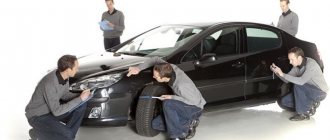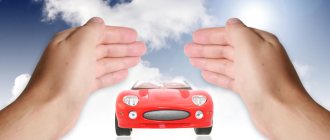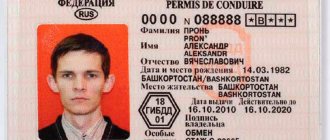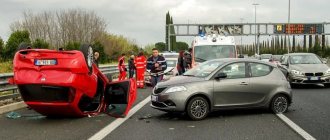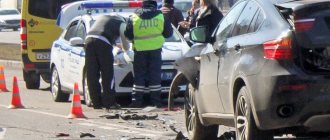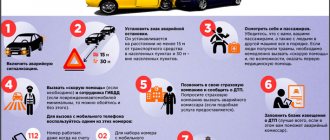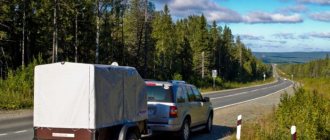Damage assessment under compulsory motor liability insurance
The procedure for paying compensation in the event of an accident is regulated by Law No. 40 of 2002 and Regulations of the Central Bank of Russia of 2014 No. 431-P.
In accordance with these regulations, payment is made on an application basis. Each fact in the application must be documented.
You can submit a claim to the insurance company:
- in which they are registered themselves (if there is no harm to life or health, and also if all participants in the accident have insurance);
- in which the culprit is registered (in any situation).
The responsibility for assessment rests with the insurance company. If the payment is underestimated, you have the right to contact an independent expert for a re-inspection. Subsequently (if the fact of underestimation of compensation is revealed), the costs can be recovered from the insurer.
Attention! Before the examination, do not take measures to repair the car. Otherwise, disagreements may arise with the insurance company.
List of expert specialties
Handwriting
- Handwriting and signature research
Author's history
- Writing Research
Technical examination of documents
- Research of document details
- Research of document materials
Phototechnical
- Study of photographic images and technical means used for their production
- Research of photographic materials
Portrait
- Identification of a person from photographic images
Traceological
- Study of human traces
- Research of traces of tools, tools, mechanisms, vehicles
Videos and sound recordings
- Voice and speech research
- Study of the sound environment, conditions, means, materials and traces of sound recordings
- Research of video images, conditions, means, materials and traces of video recordings
Weapons and gunshot marks
- Research of firearms and ammunition for them
- Investigation of traces and circumstances of the shot
- Research of edged weapons
Explosive
- Study of explosives, products and traces of their explosion
- Research of ammunition, explosive devices and traces of their explosion
- Study of gunpowders, pyrotechnic compositions and traces of their combustion
Materials, substances and products
- Study of fibrous materials and products made from them
- Research of paints and varnishes and coatings
- Research of petroleum products and fuels and lubricants
- Research of metal and alloy products
- Research of narcotic drugs, psychotropic substances and their precursors, potent and toxic substances, medicines
- Research of glass and ceramic products, silicate building materials
- Study of alcohol-containing liquids
- Research of products made of rubber, plastics and other polymeric materials
Soil science
- Study of objects of soil origin
Biological
- Research of objects of plant origin
- Research of objects of animal origin
Autotechnical
- Investigation of the circumstances of a traffic accident
- Research of technical condition of vehicles
- Research of traces on vehicles and the accident site (transport and trace diagnostics), as well as the technical condition of the road, road conditions at the accident site
- Research of vehicles in order to determine the cost of restoration repairs and residual value
- Research of the technical condition of the road, road conditions at the scene of a traffic accident
- Research of vehicles to identify defects, build quality, repairs and complaints
Fire engineering
- Research of technological, technical, organizational and other causes, conditions of occurrence, nature of the fire and its consequences
Explosive
- Research of technical and organizational causes, conditions of occurrence, nature of the explosion and its consequences at industrial, transport, agricultural and municipal facilities
Construction and technical
- Research of construction sites and the territory functionally connected with them, including for the purpose of their assessment
- Study of the circumstances of an accident in construction in order to establish its causes, conditions and mechanism, as well as the circle of persons whose responsibilities included ensuring safe working conditions
- Research of households in order to establish the possibility of their real division between the owners in accordance with the conditions set by the court; development of options for the specified section
- Study of design documentation and construction projects in order to establish their compliance with the requirements of special rules. Determination of the technical condition, causes, conditions, circumstances and mechanism of destruction of construction projects, partial or complete loss of their functional, operational, aesthetic and other properties
- Study of construction projects, their individual fragments, engineering systems, equipment and communications in order to establish the volume, quality and cost of work performed, materials and products used
- Study of residential, administrative, industrial and other buildings damaged by flood (fire) in order to determine the cost of their restoration
Accounting
- Examination of accounting records
Financial and economic
- Study of indicators of the financial condition and financial and economic activities of an economic entity
Commodity research
- Research of industrial (non-food) goods, including for the purpose of their assessment
- Food Products Research
- Research of vehicles, including for the purpose of their assessment
Psychological
- Study of human psychology and psychophysiology
- Mental State Examinations
- Examination of individual psychological characteristics
- Psycholinguistic examinations
Computer technology
- Research of information computer tools
Instrumental methods for studying forensic objects
- Application of molecular spectroscopy methods in the study of forensic objects
- Application of atomic spectroscopy methods in the study of forensic objects
- Application of radiographic methods in the study of forensic objects
- Application of X-ray spectral methods and electron microscopy methods in the study of forensic objects
- Application of chromatographic methods in the study of forensic objects
Marking designations
- Study of markings on products made of metals, polymers and other materials
Ecological
- Study of the ecological state of objects of soil-geological origin
- Study of the ecological state of natural and artificial biocenoses
- Radiation Research
- Study of the ecological state of urban environment objects
- Study of the ecological state of water bodies
Electrical appliances
- Research of radio-electronic, electrical, electromechanical devices for household use
Linguistic
- Study of speech activity products
Land management
- Research of land management objects, including determination of their boundaries on the ground
Litigation and Patent
- Research of objects of patent rights and means of individualization in order to establish their use
Deadlines
The compensation period is 20 calendar days from the date of registration of the application for the occurrence of an insured event. It includes the process of inspecting the car and conducting an examination.
Notify the insurer if you do not provide the vehicle for inspection in a timely manner. The maximum delay period cannot exceed 20 days.
If you pass again, the documents and application will be returned. Contact again. The deadlines will begin to count from the date of submission of the new application.
Within 5 days from the date of submission of the application, you are obliged to provide the vehicle for inspection:
- Independently, if the car can move “under its own power”.
- An expert must arrive at its location if the car is too damaged.
If the vehicle is located in a hard-to-reach place, the inspection can be carried out within 10 days. The costs of the examination and the visit of the expert are borne by the insurance company.
If the insurer does not schedule an inspection within 5 days, contact an independent expert. In this case, his report is taken as the basis for calculating the amount of damage, and the insurance company loses the right to demand that the car be provided for inspection.
Important! There is no need to confuse a car inspection by an expert and an insurance specialist.
To determine the amount of insurance compensation, you will need an examination conducted by an authorized person.
How does the assessment work?
Assessing the damage to a car after an accident begins with the preparation of a report by a traffic police officer. At this stage, the most important thing is that he records with utmost accuracy all the damage to the car that occurred as a result of the accident.
This determines what assessment of damage the expert will make.
You should not completely rely on the correctness of filling out the protocol. The driver must try to obtain all possible evidence of damage. To do this, you can take several personal photographs that will reflect the current situation as accurately as possible:
- vehicle position;
- car braking distance;
- position of glass fragments;
- leaked liquid from the car;
- all road signs located nearby;
- approximate time;
- weather.
It is also advisable to obtain witness statements and video from surveillance cameras, if there are any nearby. All this data will help prove innocence and receive compensation.
If you have a valid MTPL policy, you must report the incident to the insurance company within 5 business days. In this case, you need to submit the following documents:
- the insurance policy itself;
- passport;
- ownership;
- purchase and sale agreement or power of attorney;
- driver license;
- vehicle registration certificate;
- traffic police expert’s report drawn up during the accident;
- notification of an accident;
- a copy of the administrative violation report (optional);
- certificate of the decision made when considering this act (optional).
The insurance company examines these documents and sets a date and place for the examination.
The decision to pay compensation must be made within 20 working days.
Important! If the payment of compensation was not refused, then the company must pay a penalty of 1% for each day of waiting in excess of the required 20 days (Clause 21, Article 12 of the Federal Law on Compulsory Motor Liability Insurance).
By law, such an assessment can be carried out in three ways:
- self-assessment of damage;
- insurance company examination;
- independent examination.
It is possible to personally assess the damage only if the vehicle was slightly damaged and the total amount of compensation does not exceed 50 thousand rubles. Therefore, if payment of compensation was refused or you are not satisfied with its amount, then an independent examination can be carried out.
Unified calculation method
Resolution of the Central Bank of Russia of 2014 No. 433-P establishes a Unified methodology for calculating damage under compulsory motor liability insurance.
The main nuances of the unified methodology:
- Defects of the car are carried out during the initial inspection, but subsequently the list of damages may be increased.
- The amount is determined based on the cost of repairs on the date of the accident in a specific region.
- Payment under compulsory motor liability insurance is determined taking into account the wear and tear of components.
- The cost of usable parts (in case of total damage) is taken into account.
Taking into account the wear and tear of components when determining the amount of damage leads to the fact that the compensation received is not enough to restore the damage. If repairs are carried out at the expense of the insurance company, then the craftsmen use only new parts, the cost of which is higher than that of used ones.
That is, the victim finds himself in a situation where he is obliged to pay additional money to repair his car, even if he has insurance.
To avoid this, request a determination of the amount of compensation for loss of marketable value when assessing damage .
What is considered damage caused in an accident?
The concept of “damage” itself is not defined by law. Therefore, when assessing damage after an accident, they usually use Article 15 of the Civil Code of the Russian Federation, which clearly defines what “losses” are:
- real harm resulting in loss or damage to property (vehicle) owned by the victim;
- lost profits, consisting of funds that could have been received if this accident had not occurred.
Moral damage can only be demanded to be compensated by filing a lawsuit. In order to determine the final amount of money after an accident, a damage assessment is carried out.
If the insurance company underestimates the damage
Common ways to underestimate the amount of damage:
- Including only part of the damage in the calculation. Check that the company specialist takes into account not only the damage indicated in the accident certificate, but also operational damage (paint chips, scratches). As well as all hidden defects that the expert identified.
- Inclusion in the calculation of spare parts from another car brand. All information on the cost of spare parts for repairs is now freely available. Therefore, do not be lazy and calculate the amount yourself online on the RSA website.
- Excessive wear of components. To do this, the specialist carries out calculations starting from January of the year when the car was manufactured. And according to the law, the first date of registration with the traffic police is taken as the starting point.
- Reducing the cost of standard hours of work for craftsmen. These standards are established for each region individually. Information is also freely available.
If you have any suspicions that the amount of compensation has been underestimated, contact an independent appraisal company.
Attention! If false information is provided, the appraiser is obliged to pay the difference between the compensation received and the cost of repairing the actual damage.
You can check the average cost of spare parts, standard hours and materials on the RSA website.
Methods for assessing socio-economic damage from road accidents
EMRU is a unified calculation method that consists of several formulas.
The final determination of the price is based on the formula RK = SR + SM + SD, where RK is the assigned amount of compensation, resulting from the summation of SR (repair tariff), SR (price of materials) and SD (cost of parts).
When calculating CP and SM, the date and region of the accident are taken into account. When determining the SD, the depreciation of the car and the average price of the SD are taken into account (denoted as SD average).
First, the wear coefficient (K) is calculated. The formula is complex, so it is better to use an online calculator. Next, the values are substituted into the formula and the amount of damage is calculated (1-K)*SD average=SD
Contesting an assessment report
To avoid arbitrariness on the part of the insurer, the law provides for the possibility of conducting primary, repeated and additional research.
The primary one is carried out in the direction of the insurance company. A secondary one is prescribed if one of the parties to the dispute does not agree with the results of the first study. Additional appointments are provided if any questions remain. Before each new study, the initiating party is obliged to warn the other party.
If the initiator agrees with the results of the inspection, but does not agree with the conclusions of the specialist, an inspection of the vehicle is not required. It is enough to provide documentation of the inspection. This allows you to review the result even after repairs have been carried out.
If the examination results were deliberately underestimated, the insurance company may voluntarily reimburse the difference based on the claim.
To challenge the examination, proceed as follows:
- Find out the type of research conducted (commodity research, auto technical research, traceability research).
- Study the expert's opinion.
- Ask the expert to provide a reasoned explanation of the report's findings.
- Contact an independent expert to challenge the first report.
Automotive technical expertise determines the amount of damage, investigative expertise determines the circumstances of the incident, and merchandising expertise determines the amount of compensation for loss of marketable value.
If the insurance company refuses to satisfy the claims, you will have to defend your interests in court. The court does not take the reports of the insurance company or the applicant as a basis, but orders a forensic examination.
Independent assessment: pros and cons
An independent assessment of vehicle damage is a procedure that has its advantages and disadvantages. By using the services of an “outside” specialist, the car owner receives:
- “transparent” result (the expert does not “turn a blind eye” to minor or hidden damage, thereby helping the insurer reduce the amount of compensation);
- protection of their rights and interests (the car owner is forced to document his requirements when contacting the OSAGO commissioner or the court);
- compensation that allows you to completely restore the damaged car;
- evidence (in case of controversial situations).
Contacting an independent expert often makes it possible to resolve disagreements pre-trial. If it was not possible to reach an agreement, then having the conclusion of a third-party appraiser in hand, you can achieve not only the payment of compensation, but also the collection of penalties and fines from the insurance company.
The only drawback of an independent examination is the need to pay. But it can also be easily eliminated by requiring the defendant to reimburse the expenses incurred.
Independent examination
To receive fair compensation:
- Ask your insurer for an independent assessment of the damage.
- Receive a referral for an expert examination.
- Visit him on the appointed day and time.
- Get the report.
If you do not agree with the amount of compensation, then:
- Find an appraisal company that is licensed to perform post-accident vehicle inspections.
- Make a contract with her.
- Notify your insurer about this.
- Do your research and get a report.
- File a claim and attach a new report to it.
If the insurer's decision is positive, you will receive not only a payment in accordance with the results of the report, but also reimbursement of expenses for the expert .
Documentation
To re-assess the damage you will need:
- passport;
- documents for the car (PTS, STS);
- referral for examination from the insurance company;
- documentation of the incident (certificate of road accident and others);
- other documents required by the expert.
The appraiser must be a member of the SRO and confirm that he has a license for appraisal activities. You can check this information using the link.
How to assess car damage after an accident
So that no one can make a claim against you that your actions are illegal, you should act competently and correctly. There is a certain procedure that must be followed even if you decide to contact independent appraisers. So, how to assess the damage to a car in an accident? A sequential order of actions should be considered.
- The first block of actions is to respond correctly at the scene of the incident. Do not forget to take the following documents from the police officer: • a certificate of an accident; • conclusion on not opening criminal proceedings. After the event has occurred, you need to fill out the paper that is attached to any MTPL policy. This is an accident notice.
- You must notify your insurers by phone about the occurrence of an insured event. If you are not the culprit of the accident, then all payments must be compensated by the insurance agent of the other party to the accident. However, although you have 10 days to contact the company, you should report the occurrence of an insured event immediately. Otherwise, there may be problems with receiving payments.
- You need to choose your own independent expert. There is no need to wait until the insurance company gives directions to undergo an examination. Choose such a company yourself; remember, if you are their client, and not an insurance company, then this company will be interested in performing its services conscientiously and objectively.
- An agreement should be concluded with an appraiser. The contract for conducting an automobile examination is concluded between the driver and the company. It contains personal data, as well as technical data of the car that is subject to inspection. This document must indicate the exact time and date for which the examination is scheduled. This is a very important point from a legal point of view.
- We notify interested parties.
As a rule, notice of the upcoming independent examination must be sent by mail. Among the warned persons should be all participants in the accident, as well as the insurance company that will have to make payments. Important! Warnings must be sent out at least 5 days before the expected date of the vehicle examination. Otherwise, the results of the commission may be contested. - On the specified day, appear for the examination and receive a conclusion. All parties are welcome to attend this event. If they disagree with something, they will have to indicate specific aspects in the document and sign. If someone does not show up to inspect the car, this is their personal problem. The driver is not responsible for this.
So, it became clear how a specialist assesses the damage to a car in an independent examination. What papers are required?
Let's sum it up
To fully assess the damage under compulsory motor liability insurance, you must consider the following:
- Payment under compulsory motor liability insurance is carried out on an application basis.
- The first examination is carried out at the initiative of the insurer and at his expense.
- The result of the first study may be underestimated, so be actively involved in the evaluation process at each stage.
- If you suspect that the amount of compensation has been underestimated, contact an independent expert.
- Often the appraisal report and claim are sufficient to obtain a full refund. Otherwise, go to court.
More…
- What does MTPL cover in case of an accident and how much damage does extended insurance cover?
- Payment under compulsory motor liability insurance or repairs, what is better to choose, who decides and how to get money
- Where to apply for compulsory motor liability insurance for a victim after an accident
- Is the culprit of the accident paid insurance under compulsory motor liability insurance?
Payment table for compulsory motor liability insurance
RSA has developed lists that contain information that allows you to determine the insurance premium. The spare parts cost table contains average information about the price of parts, standard hours and consumables. It is better to familiarize yourself with the table on the RCA website; it contains more than 80 million items.
In addition to paying for repairs, payments may be made to injured passengers and the driver. Payment is made based on recorded injuries. If there were several, then payment will be made for each.
Basic OSAGO rates
Payments under OSAGO
Place several tables of insurance payments (by region, by insurance campaign)
Car condition assessment by an insurance company
After an emergency situation occurs where the driver suffers losses, according to the MTPL insurance policy, the car owner has the right to demand compensation for damage from the insurer. After filling out the protocol, the victim, within 5 days, contacts the insurance company where he purchased the insurance.
The insured person must take with him:
- identification code;
- passport and driver's license;
- documents for the car;
- completed protocol;
The insurance agent who will accept the documents obliges you to write a statement about the occurrence of an insured event. The form must indicate how the vehicle will be assessed. Here you need to be vigilant, the insurer will insist that the examination be carried out by an insurance company employee, but any driver has the right to use the services of an independent expert.
The cost of repairs is affected not only by the degree of damage to the car in an accident, but also by the actual wear and tear of the vehicle at the time of the road accident. The calculation of the cost of repairs is based on average market prices that are relevant for the region where the emergency occurred.
IMPORTANT !!! During the examination, you need to take care of photo and video evidence, not only of the accident that occurred, but also of the damage caused to the car.
If this is not done, the Investigative Committee may challenge the results of the independent examination. The total amount of vehicle repairs cannot be more than the market value of the car.
When a car owner turns to independent experts, he can use various services - determining the cost of repairing a vehicle, appraising a car without drawing up a report, detailed calculations, legal support, and the insurer can only estimate how much money needs to be paid to the client for repairs.


